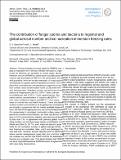The contribution of fungal spores and bacteria to regional and global aerosol number and ice nucleation immersion freezing rates
Author(s)
Spracklen, D. V.; Heald, Colette L.
DownloadSpracklen-2014-The contribution of.pdf (692.5Kb)
PUBLISHER_CC
Publisher with Creative Commons License
Creative Commons Attribution
Terms of use
Metadata
Show full item recordAbstract
Primary biological aerosol particles (PBAPs) may play an important role in aerosol–climate interactions, in particular by affecting ice formation in mixed phase clouds. However, the role of PBAPs is poorly understood because the sources and distribution of PBAPs in the atmosphere are not well quantified. Here we include emissions of fungal spores and bacteria in a global aerosol microphysics model and explore their contribution to concentrations of supermicron particle number, cloud condensation nuclei (CCN) and immersion freezing rates. Simulated surface annual mean concentrations of fungal spores are ~ 2.5 × 10[superscript 4] m[superscript −3] over continental midlatitudes and 1 × 10[superscript 5] m[superscript −3] over tropical forests. Simulated surface concentrations of bacteria are 2.5 × 10[superscript 4] m[superscript −3] over most continental regions and 5 × 10[superscript 4] m[superscript −3] over grasslands of central Asia and North America. These simulated surface number concentrations of fungal spores and bacteria are broadly in agreement with the limited available observations. We find that fungal spores and bacteria contribute 8 and 5% respectively to simulated continental surface mean supermicron number concentrations, but have very limited impact on CCN concentrations, altering regional concentrations by less than 1%. In agreement with previous global modelling studies, we find that fungal spores and bacteria contribute very little (3 × 10[superscript −3]%, even when we assume upper limits for ice nucleation activity) to global average immersion freezing ice nucleation rates, which are dominated by soot and dust. However, at lower altitudes (400 to 600 hPa), where warmer temperatures mean that soot and dust may not nucleate ice, we find that PBAP controls the immersion freezing ice nucleation rate. This demonstrates that PBAPs can be of regional importance for IN formation, in agreement with case study observations.
Date issued
2014-09Department
Massachusetts Institute of Technology. Department of Civil and Environmental EngineeringJournal
Atmospheric Chemistry and Physics
Publisher
Copernicus GmbH on behalf of the European Geosciences Union
Citation
Spracklen, D. V., and C. L. Heald. “The Contribution of Fungal Spores and Bacteria to Regional and Global Aerosol Number and Ice Nucleation Immersion Freezing Rates.” Atmospheric Chemistry and Physics 14, no. 17 (2014): 9051–9059.
Version: Final published version
ISSN
1680-7324